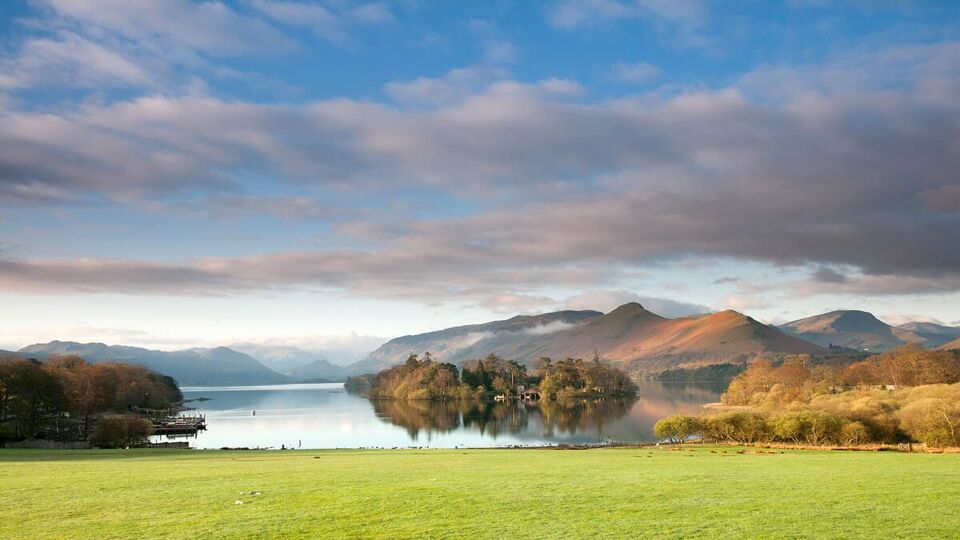Windermere
Price £55
Min age 5
Rating 4.84 / 5 [1508 ratings]
Tour supplied by:
Bucket list destination:
Cumbria, United Kingdom (UK)

The Lake District is a land of superlatives; the highest peaks in England, the deepest lakes, the most spectacular scenery. There is a wildness to the landscapes and a sense of nature on a grand scale, found in few other places in the British Isles.
It’s best-known as the heartland of British hiking, and it’s a brilliant place to go to explore the great outdoors, whether that means walking, climbing, boating or biking. Literary buffs will also find plenty to divert them: Beatrix Potter and William Wordsworth were both inspired by the Lakeland landscape, and several of their former homes can be visited.
The Lake District is split roughly in two halves. The eastern side is home to the largest lake, Windermere, and the busy tourist towns of Ambleside and Bowness-on-Windermere. The western half feels much wilder and emptier, and is home to the highest fells including Scafell Pike, England’s tallest peak at 978m. This is the place for serious walking and dramatic scenery, but there are fewer places to stay.
Northeast of Windermere lies Ullswater, the second-largest of Lakeland’s lakes. Further north still is Derwentwater, with the attractive market town of Keswick situated at its northern end.
Our selection of the best Viator tours of this destination, plus helpful tickets and transfers
Windermere
Price £55
Min age 5
Rating 4.84 / 5 [1508 ratings]
Tour supplied by:
Manchester
Price £75
Min age 5
Rating 4.86 / 5 [198 ratings]
Tour supplied by:
Liverpool
Price £59
Min age 0
Rating 4.74 / 5 [185 ratings]
Tour supplied by:
Windermere
Price £159
Min age 0
Rating 4.96 / 5 [153 ratings]
Tour supplied by:
Windermere
Price £35
Min age 5
Rating 4.90 / 5 [82 ratings]
Tour supplied by:
If you can, avoid visiting the Lakes in July and August, when it gets unpleasantly crowded and prices are highest. Easter and bank holidays can also be very busy. Better to visit in the quieter shoulder seasons – try April or May, when the lake shores are dusted with Wordsworthian daffodils, or September or October, when the hills are alight with autumnal colour.
The M6 skirts the eastern edge, with the main entry points being Kendal and Penrith. Trains from London Euston to Windermere take just under four hours, with a change at Preston or Oxenholme.
Cars are the most practical way to get around, but in the summer months roads get horribly congested – and parking can be very expensive. Most of the major tourist hubs such as Keswick, Ambleside and Grasmere, have taxi services.
It is feasible to get around by bus, with regular services between the main towns. See the Lake District website for details.
Cycling is another option, although you won’t get away without tackling some hills; the 599 bus between Bowness and Grasmere has space to carry two bikes, and it’s also possible to take your bike on the Windermere Ferry. See the Lake District website for further details on cycling.
Many visitors choose to stay in one of the towns or villages around Lake Windermere, where hotels and B&Bs abound, especially around Bowness-on-Windermere, Windermere Town and Ambleside.
Villages like Hawkshead, Coniston, Elterwater and the surrounding areas are much quieter, and have plenty of excellent pubs, country hotels and cottages to choose from.
In the northern part of the park, Keswick is the most practical base, with easy access to the beautiful valleys of Borrowdale and Buttermere nearby, and great mountain biking in nearby Whinlatter Forest.
In the western part of the park, there is a handful of places to stay around the remote valleys of Wasdale and Eskdale, including some classic inns and great campsites, but do be aware you’re a long way from anywhere.
Don’t overlook the outer edges of the park: accommodation is often easier to come by in Cockermouth, Kendal, Ulverston and Penrith, and nearly always a good deal cheaper too.